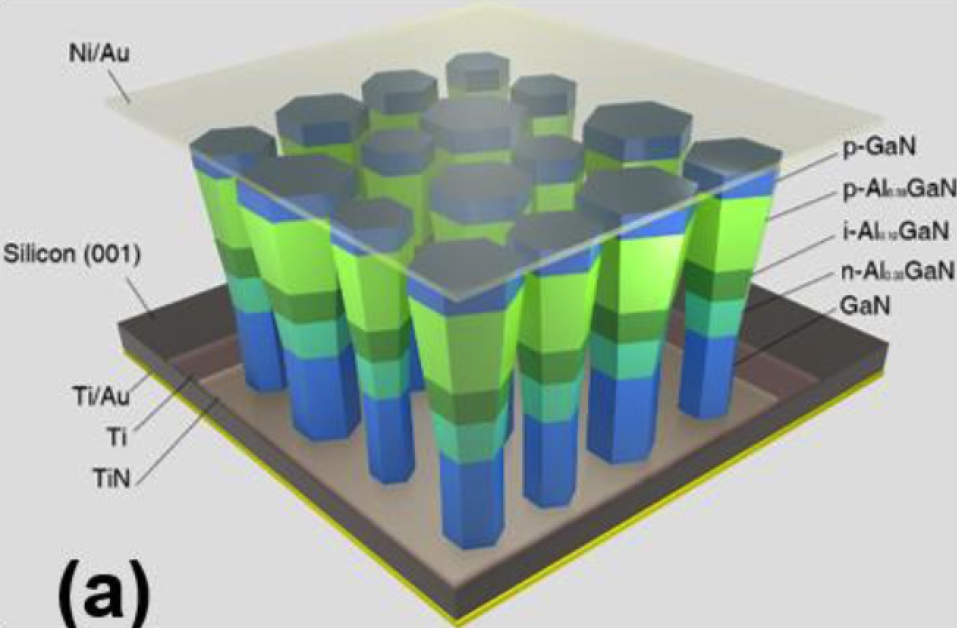KAUST team Cleans Nanowires for more Efficient UVLEDs

Diluted KOH shown to be an environmentally friendly surface passivation solution for making more efficeint AlGaN nanowire-based devices
Despite demand for more compact, environmentally-friendly, and reliable ultraviolet (UV) sources, the performance of UVLEDs has remained limited. This is due to several factors such as a high density of defects and dislocation and the lack of efficient thermal dissipation channels under current device schemes.
To date, the best-attained wall plug efficiency (WPE) for UVLEDs (emitting wavelength<340 nm) is below 15 percent at 20 mA, and the WPE value drastically drops with decreasing wavelength. Additionally, the output power also drops significantly at high current injection due to 'thermal droop'. Consequently, conventional planar UVLED structures face tremendous challenges and new device scheme to achieve high efficient UVLEDs are urgently needed.
Recently, dislocation-free AlGaN nanowires have attracted attention as an alternative. Such nanowires can be grown on metals with higher efficiency heat dissipation than conventional substrates such as silicon and sapphire.
However, due to the large surface-to-volume ratio of nanowire structures, the optical and electrical properties of nanowire-based structures are highly sensitive to their surroundings. A significant presence of surface states and hence an increasing non-radiative recombination rate at these surface state/defect centres will reduce the efficiency of these devices. Thus, it is crucial to remove the surface defects and suppress the undesirable surface recombination on nanowires' surface.
In the past, scientists have used toxic and hazardous chemicals to treat nitride nanowires to enhance device performance. Now, a team of scientists from KAUST (King Abdullah University of Science and Technology) in Saudi Arabia, led by Boon Ooi and Xiaohang Li, has demonstrated, for the first time, that diluted potassium hydroxide (KOH) can be used as an environmentally-friendly alternative to remove surface oxidation in MBE-grown AlGaN nanowires. (KOH solution is commonly used as a follow-up step after dry etching of GaN-based thin films or used in the top-down fabrication of nanorod devices.) The technique was published by Haiding Sun et al in ACS Photonics.
Sun and colleagues investigated the underlying passivation mechanism and its effects on the optical properties of AlGaN nanowires grown on a metal substrate and then studied the effect of the KOH passivation of different durations on the optical performance of the fabricated UVLEDs. (Figure a) above shows a 3D schematic depiction of the fabricated 300 à…~ 300 μm2 nanowire UVLED).
Electroluminescence results indicated that the output power is increased by about 49.7 percent with a lower turn-on voltage in the fabricated UVLEDs emitting at 337 nm after KOH passivation. Furthermore, the observation of relatively increased carrier lifetimes after passivation is mainly due to the success in reducing of surface states.
The graph on the left shows current−voltage characteristics of the fabricated sample before and after passivation. The inset shows the reverse current in log scale. The graph on the right shows measured light output power as a function of the injection current. The inset shows the EL spectra at an injection current of 300 mA before and after passivation at room temperature.
"Our approach in addressing the significant reducing of surface defects and thus improving UVLED performance is effective and environmentally-friendly", said the first author Haiding Sun, "We anticipate that this passivation procedure will find broad practical applications in fabricating self-assembled nanowire-based high-efficient light emitting devices, lasers, photodetectors, modulators etc. "
'Surface-Passivated AlGaN Nanowires for Enhanced Luminescence of Ultraviolet Light Emitting Diodes' by H. Sun, et al; ACS Photonics, DOI: 10.1021/acsphotonics.7b01235.


































